Other Parts Discussed in Thread: IWR1443
Hi,
I need to put the radar in the enclousure with the glass window. Ultimately, I will need to detect obstacles as cloud of points at a distance of about 3m. I made the test by placing IW1443BOOST in 2cm behind the glass window and put two cups at a distance of about 0.5m. I saw that through the glass the radar "can see" the cups much worse. In addition, it "sees" fake objects at a distance of up to 10cm and sometimes fake points appear at a greater distance. I also noticed that the radar better detects the cups on 2Tx antenna config than on 3Tx antennas. My config was:
- range res: 0.047m
- max unambiguous range: 2.41
- range detect tresh: 9dB
If I set the lower threshold value, it was better to detect the cups, but of course there were also more fake points detected.
Please tell me how to correctly configure IWR1443BOOST to "see" well through the glass window at small distances.
Thanks in advance.
1) IWR1443 through glass (2Tx config):
2) IWR1443 without glass (2Tx config):



